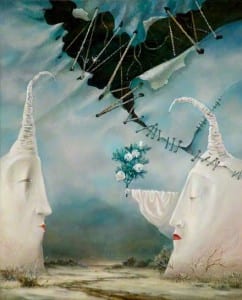On initial viewing of the Painting- ‘The Brayford Pool and Lincoln Cathedral’ (1858) hanging in The Usher Gallery, my group and I saw great beauty, artistic flare and appreciated the feeling of going back in time and visiting what Lincoln once was. We intended to create our performance based on these differences and the culture change in Lincoln. After some further discussion we realised we needed some outside perspective and during our time spent in the Usher Gallery in class we asked various different people their opinions of the painting. We recieved a lot of positive responses about how beautiful it was, and how well the cathedral is captured as well as the busyness portrayed in the painting and how precise the detail is. However we then questioned one gentleman who gave us much more negative feedback. He spoke about how flat the painting was, saying it was lifeless and unrealistic. We took these comments in our stride but still feeling positive about our views and ideas. We then had an interesting discussion with a woman who had a varied view. She mentioned the busyness in the painting, how well the light was captured and questioned whether the cathedral was to be the focul point because it comes accross very poignant. She then began to question the honesty of the painting, saying it looks like a photograph, the swans all seem perfectly placed, everyone is well dressed and the boats are in good condition. ‘Surely it woudln’t be this perfect’ she said. We then realised we hadn’t read in full the small sign next to the painting on which the full title and description of the painting is written. It states clearly that the painting was an idealised image and the swans and fishermen were painted in for this reason. This turned our whole view of the painting on its head and twisted our vision. We then began to consider our performance being an unveiling of what the painting should look like and also a presentation of our opinions of the dishonesty of the painting and the era in which it was painted. It’s interesting to link this to todays society and when you really think about it, do we ever actually see the ‘real’ thing? Or is it a photoshopped version? Is it something people want us to see? Even when we take photographs of ourselves or of somehting which is already beautiful we edit, we crop and we criticise. Much like the well known iphone app called Instagram; the place where everything looks better than it actually is and a plate of beans on toast is made to look like a masterpiece. We have the option to filter a photograph and edit out any imperfections that might make it unique, so we do it, and then it looks like any other Instagram post; all the same.

This photograph is one I have taken of two swans spontaneously posing in a heart shaped position, taken on the Brayford pool. The background isn’t the most beautiful and the water isn’t the cleanest but the image of the swans is still beautiful.

This is the same photograph after I have edited it on Instagram and instantly it is more attractive and inviting. Anything ugly about the picture has been dismissed, the reflection in the water is clear and the image is a much more beatiful one. But it isn’t real, it has been altered just so it is more pleasing to the eye. Without anything in the photgraph but the swans, it could have been taken anywhere as long as this image was captured.
So when you really think about it, it’s as if the artist of ‘The Brayford Pool and Lincoln Cathedral’ has instagramed the painting to make something that was probably quite average in to a master piece, and something people really want to see.


